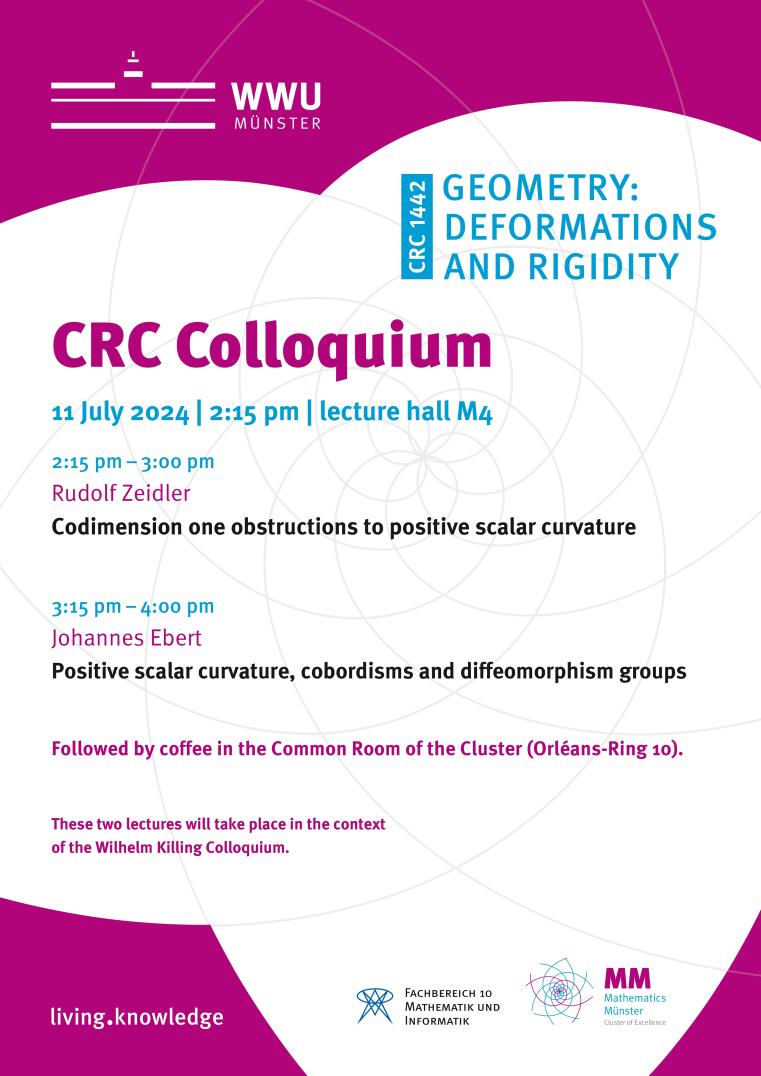

Kolloquium
des SFBs 1442 Geometrie: Deformationen und Rigidität
am Donnerstag, 11. Juli 2024
um 14:15 Uhr
im Hörsaal M4
Codimension one obstructions to positive scalar curvature
Sprecher: Rudolf Zeidler
A classical strategy to study the existence question of positive scalar curvature (PSC) metrics is to (successively) reduce the dimension by one to simplify the problem. This goes back to the 1979 proof of the positive mass theorem by Schoen–Yau via minimal hypersurfaces. More recently, an augmentation of minimal hypersurfaces known as "mu-bubbles“ has greatly extended the power of this strategy and lead to advances such as the non-existence of PSC metrics on aspherical 4- and 5-manifolds due to Chodosh–Li and Gromov. In this talk, in addition to a gentle introduction and a survey of recent results, I will discuss a conjecture due to Rosenberg and Stolz which predicts that a closed manifold $M$ (of dimension $\neq 4$) admits a positive scalar curvature (PSC) metric if and only if $M \times \mathbb{R}$ admits a complete PSC metric. I will explain a proof of this for orientable manifolds up to ambient dimension 7 by combining mu-bubble techniques with positive scalar curvature cobordism theory. This result was obtained in a joint work together with Cecchini and Räde.
Positive scalar curvature, cobordisms and diffeomorphism groups
Sprecher: Johannes Ebert
I will explain the role of cobordism theory in the study of positive scalar curvature on high--dimensional manifolds. This starts with the Gromov--Lawson surgery theorem and unfolds its consequences, some of which are classical and some of which have been discovered by the speaker and his collaborators in the last decade. \begin{enumerate} \tem The surgery theorem reduces the existence question for metrics of positive scalar curvature (in the high--dimensional regime) to a problem in cobordism theory which can in some cases be completely solved by means of stable homotopy theory. \item The homotopy type of the space $\mathcal{R}^+ (M)$ of metrics of positive scalar curvature only depends on the cobordism class of $M$, when the notion of cobordism is interpreted correctly. \item In some cases, that homotopy type does not even depend on the cobordism class of $M$. \item The natural action of the diffeomorphism group of $M$ on $\mathcal{R}^+ (M)$ has a remarkable rigidity property; saying that often the diffeomorphism group acts trivially in a suitable sense. \item This rigidity property, combined with high--dimensional Madsen--Weiss theory, leads to the construction of a great wealth of elements in the homotopy groups in $\mathcal{R}^+ (M)$. \end{enumerate} The results we explain are either classical (mostly due to Gromov--Lawson and Stolz) or were obtained in joint works with Randal--Williams, Botvinnik and Wiemeler; or proven in the theses by Frenck, Bantje and Mantione.

